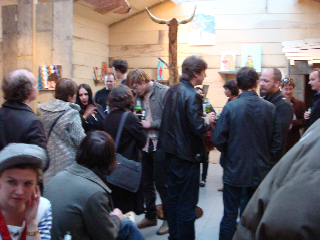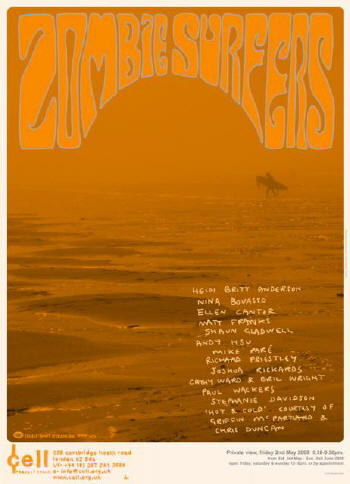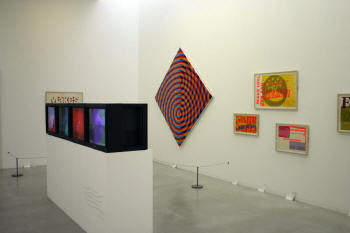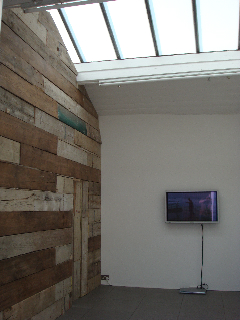|
Richard Priestley on Cell Project Space and surfing at Sennen
Richard Priestley is
co-founder and co-director of 'Cell Project Space' in the East End of
London
 'Cell
Project Space' is on Cambridge Heath Road,
midway between the Whitechapel and the Chisenhale in the East End,
isnt it? How long has it been going and
what is your role within it? 'Cell
Project Space' is on Cambridge Heath Road,
midway between the Whitechapel and the Chisenhale in the East End,
isnt it? How long has it been going and
what is your role within it?
To give you an idea of the history and purpose of Cell:
I formed Cell Project Space with co-founder
Milika Muritu in 2000. We were both artists trying to find a way to
finance our own studios and create an experimental platform for showing
the work of artists we were interested in. We achieved this by taking on
a run down floor of an industrial building in Tyssen Street, Dalston,
which provided studios for 20 artists, and whose rent funded the
programme at the Project Space.
We soon moved to Arcola Street in Dalston ( usual story, developers
pushing artists out...) and as we began to take longer leases on more
buildings to generate longer term security for the exhibition programme
and the organisation, we moved to our long term site at Cambridge Heath
Road after putting on a satellite one off show at this site when we
first signed the lease, before we began building the studios. The
visitor numbers were dramatically higher than Dalston,
so we decided to make a permanent move to that part of east
London. There were a small number of galleries
in the area at that point (Wilkinson, The
Showroom, Interim and The Approach ) but the numbers of spaces have
grown dramatically since, along with the number of artists studios in
the area.
Cell has always been self funding and relies on neither commercial sales
of work from the project space, nor any kind of external or core
funding, to run. The founders built the studios themselves initially to
get the organisation off the ground. Both founders/directors continue to
work as artists and curate exhibitions at Cell and other spaces. We are
constantly striving to expand our studio provision in order to meet the
high demand for artists studios in London, and continue to charge lower
than market value rents. We currently provide studio space for over 200
artists in five buildings in east london.
 That's impressive. So how
does Cell fit into the London art scene in general? That's impressive. So how
does Cell fit into the London art scene in general?
We're very much part of the furniture of the East
End circuit and scene, though as a self-funding
and non- commercial project space we are
unique. Our programme is very much international and will often showcase
artists never seen before in the UK, as well as recent graduates and
well established practitioners. We are dedicated to protecting and
providing networks for artists through our project space programme and
studio environments.
Zombie Surfers was a show at Cell in late
Spring 2008. How did it
came about exactly?
(see exhibitions for more
pictures)
Muritu and myself have been boardriders for many years, but got hooked
up on surfing (as opposed to snowboarding) just a couple of years ago.
Cornwall and Devon have long been favourite camping destinations for us,
so hitting surf spots at the same time fitted together perfectly.
There is a continuous dialogue between us about artists and shows, which
never slows down or shuts up. This is partly down to us always searching
for an angle for a show, finding the dialogue through artists we think
can expand the theme. For me the themes are usually something I am
personally very interested in and driven by.
Zombie Surfers became a clear concept for a show after a weird surf
session at Sennen Cove,
Cornwall. This heavy fog drifted in and we
really had no sense of which direction dry land was as the swell dropped
off. There were just a few other grey figures bobbing in the murk. It
was very Stephen King. Back on land later on, we spotted a hearse parked
by the storm wall with a couple of longboards on its roof and
shortboards in the back where the dead normally travel, and the title
for the show was nailed. The editor of Stranger magazine actually knew
and put me in touch with the owner of the hearse.
The zombies represent the relentlessly driven. This applies as easily to
myself and other artists, or to surfers - both driven and obsessive
about their passion, stumbling towards their goal...
I am fascinated with sub cultural groups, and wanted to make a show
which examined the hierarchies within subcultures. The surf community
offered the chance for me to indulge my relatively new found passion but
at the same time draw parallels with hierarchies within the art world.
Both have mainstream and accessible parts, but equally they have inner
and almost inaccessible and esoteric sanctums and circles. These inner
circles are what draw me in, moth to a flame style.
 Its interesting how these things come about.
Roughly a year ago we had a Brian Wilson-themed show at Tate St
Ives, which Alex Farquharson curated
(picture right). Some
surf themes were there in a subtle way, but they
are
obviously more explicit in your show. I guess you could do this
because there's something witty and surreal
about having a surf shack in the middle of London. Do you want to expand
on the idea of the surf shack and how it functioned? Its interesting how these things come about.
Roughly a year ago we had a Brian Wilson-themed show at Tate St
Ives, which Alex Farquharson curated
(picture right). Some
surf themes were there in a subtle way, but they
are
obviously more explicit in your show. I guess you could do this
because there's something witty and surreal
about having a surf shack in the middle of London. Do you want to expand
on the idea of the surf shack and how it functioned?
I saw this show.
The seed for Zombie Surfers was already planted, so I
was a little nervous about it, but needn't have been. I mostly really
liked Farquharson's 'If Everybody Had An Ocean' at Tate St Ives. We've
shown some of the artists included at Cell, but the dialogue and
direction were pretty far apart, really.
My own practice involves creating a physical framework in the form of an
installation in which to display the artists invited to participate in
the show. The framework is dictated to by the theme and concept, so in
this case a surf shack, as symbol of the club house and network of the
surf community, was appropriate. The aim was to make a shack, rather
than shop, where the artworks were the collection of the shack keepers
alter ego, shown alongside my collection of boards and other surf
products, memorabilia, films, etc.
 Is the title a bit of an homage to
BANK who put on 'Zombie Golf' in the eighties? They used to
create environments in which other artists would be exhibited. Is the title a bit of an homage to
BANK who put on 'Zombie Golf' in the eighties? They used to
create environments in which other artists would be exhibited.
We know and have
exhibited the individual work of most of the BANK artists at Cell over
the years, but I do not feel their influence
in what I did with Zombie Surfers. I do think
they helped to create a culture in which an organisation like Cell could
exist and survive though.
Some of the work included is,
on one level, reminiscent of the
psychedelic art that came out of San Francisco and California at pretty
much the same time as surfing started going global. I'm not too familiar
with this area, but eg the name Rick Griffin comes to mind. Or are
there other aspects of surf culture that you are particularly interested in?
Griffin's work really isn't where I'm at, nor
anyone I know. The Filmore movement, however,
is a constant source of inspiration on a poster layout and typographic
level, as all of Cells exhibition invites have always been 2 colour A3
poster size. My interest in surfing history is much more beat, and
orientated towards the 1950's to early '60's. Films and film posters
from film makers such as Don Brown, Jim Freeman and John Severson
capture the spirit of the US west coast scene really well and form the
foundation of US surf nostalgia. Zombie Surfers includes artists from
Australia, Canada and all over the US as well as Europe - some are
surfers, some just happen to have adopted a visual language which I felt
worked with the dialogue of the show.
The iconography used by mainstream surf
culture, which is, of course, mostly hugely commercialised now, is
really very conservative and repetitive; throw
in a few skulls and the odd rainbow and you've got your new T-shirt
design or ad campaign...again.
My own passion for surfing is driven by actually doing it. It keeps me
really fit and as an all winter surfer, has made me a bit more hardy. It
demands complete focus, which heals me of the stresses of the rat race
sufficiently to keep me 'trudging towards the light', and has affected
where I spend part of my life.
interviewer Rupert White
http://www.artcornwall.org/exhibitions/zombie_surfers.htm
|

 'Cell
Project Space' is on Cambridge Heath Road
'Cell
Project Space' is on Cambridge Heath Road

 Is the title a bit of an homage to
BANK who put on 'Zombie Golf' in the eighties? They used to
create environments in which other artists would be exhibited.
Is the title a bit of an homage to
BANK who put on 'Zombie Golf' in the eighties? They used to
create environments in which other artists would be exhibited.